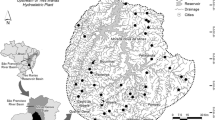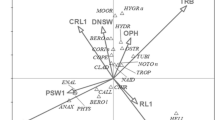Abstract
In depressional freshwater wetlands, habitat size, hydrology, and fish predation are considered key controls on invertebrate assemblages. However, the relative importance of each of these factors is difficult to isolate because the factors are frequently correlated. We assessed controls exerted by habitat size, hydrology, and fish occurrence in a set of 10 Carolina bay wetlands where these factors were largely independent. Invertebrate assemblages were sampled seasonally for six years. Using Joint Species Distribution Modeling of presence/absence and relative abundance data, < 6% of the variance in overall invertebrate assemblages was explained by the combined effects of size, hydrology, and fish occurrence: hydrology explained the most. However, when assessing responses of individual taxa, 32% were responsive, again primarily to variation in hydrology. Habitat size was minimally important. Fish occurrence affected only a handful of taxa, but some of those were key ecologically (abundant consumers). Most taxa responded to only one of the three environmental factors; effect sizes for responses ranged from 2 to 15.6% of total variance explained. Overall, the influences of habitat size, hydrology, and fish occurrence were less important to invertebrates in Carolina bay wetlands than we had presumed, given the prominence of these controls in the wetland invertebrate literature.

Similar content being viewed by others
Data availability
Data are available upon reasonable request to the senior author.
References
Batzer, D. P., 2013. The seemingly intractable ecological responses of invertebrates in North American wetlands: a review. Wetlands 33: 1–15. https://doi.org/10.1007/s13157-012-0360-2.
Batzer, D. P. & S. A. Wissinger, 1996. Ecology of insect communities in nontidal wetlands. Annual Review of Entomology 41: 75–100.
Benke, A. C., I. Chaubey, G. M. Ward & E. L. Dunn, 2000. Flood pulse dynamics of an unregulated river floodplain in the Southeastern US coastal plain. Ecology 81: 2730–2741.
Bird, M. S., M. C. Mlambo & J. A. Day, 2013. Macroinvertebrates as unreliable indicators of human disturbance in temporary depression wetlands of the south-western Cape, South Africa. Hydrobiologia 720: 19–37. https://doi.org/10.1007/s10750-013-1618-2.
Euliss, N. H., J. W. LaBaugh, L. H. Fredrickson, D. M. Mushet, M. K. Laubhan, G. A. Swanson, ... & R. D. Nelson, 2004. The wetland continuum: a conceptual framework for interpreting biological studies. Wetlands 24: 448–458.
Gelman, A. & D. B. Rubin, 1992. Inference from iterative simulation using multiple sequences. Statistical Science 2: 45–52.
Hall, D. L., M. R. Willig, D. L. Moorhead, R. W. Sites, E. B. Fish & T. R. Mollhagen, 2004. Aquatic macroinvertebrate diversity of playa wetlands: the role of landscape and island biogeographic characteristics. Wetlands 24: 77–91.
Kirkman, L. K., L. L. Smith & S. W. Golladay, 2012. Southeastern depressional wetlands. In Batzer, D. P. & A. H. Baldwin (eds), Wetland Habitats of North America; Ecology and Conservation Concerns University of California Press, Berkeley: 203–215.
MacArthur, R. M. & E. O. Wilson, 1967. The Theory of Island Biogeography, Princeton University Press:
Nienhaus, H., S. W. Fitzpatrick, D. D. Bloom & T. A. Schriever, 2023. Dispersal ability and biogeographic gradients influence gene flow of 3 aquatic insects in Laurentian Great Lakes interdunal wetlands. Freshwater Science 42: 88–103. https://doi.org/10.1086/723893.
Oertli, B., D. A. Joye, E. Castella, R. Juge, D. Cambin & J. B. Lachavanne, 2002. Does size matter? The relationship between pond area and biodiversity. Biological Conservation 104: 59–70.
Ovaskainen, O., & N. Abrego, 2020. Joint species distribution modelling. With applications in R. Cambridge University Press.
R Core Team, 2022. R: A language and environment for statistical computing. R Foundation for Statistical Computing, Vienna, Austria. https://www.R-project.org/.
Sharitz, R. R., D. P. Batzer & S. C. Pennings, 2014. Ecology of freshwater and estuarine wetlands: an introduction. In Batzer, D. P. & R. R. Sharitz (eds), Ecology of freshwater and estuarine wetlands 2nd ed. University of California Press, Berkeley: 1–22.
Tikhonov, G., Ø. H. Opedal, N. Abrego, A. Lehikoinen, M. M. De Jonge, J. Oksanen & O. Ovaskainen, 2020. Joint species distribution modelling with the r-package Hmsc. Methods in Ecology and Evolution 11: 442–447.
Vanschoenwinkel, B., A. N. N. Hulsmans, E. De Roeck, C. De Vries, M. Seaman & L. Brendonck, 2009. Community structure in temporary freshwater pools: disentangling the effects of habitat size and hydroregime. Freshwater Biology 54: 1487–1500. https://doi.org/10.1111/j.1365-2427.2009.02198.x.
Wellborn, G. A., D. K. Skelly & E. E. Werner, 1996. Mechanisms creating community structure across a freshwater habitat gradient. Annual Review of Ecology and Systematics 27: 337–363.
Wiggins, G. B., R. J. Mackay & I. M. Smith, 1980. Evolutionary and ecological strategies of animals in annual temporary pools. Archiv Für Hydrobiologie, Supplement 58: 97–206.
Wissinger, S. A., 1999. Ecology of wetland invertebrates: synthesis and applications for conservation and management. In Batzer, D. P., R. D. Rader & S. A. Wissinger (eds), Invertebrates in freshwater wetlands of North America: Ecology and management Wiley, New York: 1043–1086.
Zimmer, K. D., M. A. Hanson, M. G. Butler & W. G. Duffy, 2001. Size distribution of aquatic invertebrates in two prairie wetlands, with and without fish, with implications for community production. Freshwater Biology 46: 1373–1386.
Acknowledgements
This study statistical analyses were supported in part by resources and technical expertise from the Georgia Advanced Computing Resource Center, a partnership between the University of Georgia’s Office of the Vice President for Research and Office of the Vice President for Information Technology. We thank Nyree Riley and Kelly Murray-Stoker for assistance with field sampling, and Joseph McHugh (Coleoptera, Sisyridae) and Gabriela Cardona Rivera (Odonata) with help in confirming genus classifications.
Funding
DPB was supported, in part, by the USDA Hatch Program. LBE was supported by CONICET and Fulbright.
Author information
Authors and Affiliations
Contributions
DPB developed the conceptual and theoretical basis for the paper, collected and processed much of the data, and wrote the manuscript. LBE contributed to the theory, conducted statistical modeling, and developed the figure. SR contributed to the theory, collected and processed much of the data, and assisted in development of the supplementary table.
Corresponding author
Ethics declarations
Conflict of interest
The authors have no conflicts of interest.
Additional information
Handling editor: Dani Boix
Publisher's Note
Springer Nature remains neutral with regard to jurisdictional claims in published maps and institutional affiliations.
Supplementary Information
Below is the link to the electronic supplementary material.
Rights and permissions
Springer Nature or its licensor (e.g. a society or other partner) holds exclusive rights to this article under a publishing agreement with the author(s) or other rightsholder(s); author self-archiving of the accepted manuscript version of this article is solely governed by the terms of such publishing agreement and applicable law.
About this article
Cite this article
Batzer, D.P., Epele, L.B. & Reindl, S. Assessing the relative impacts of habitat size, hydrology, and fish occurrence on aquatic invertebrate assemblages in a set of depressional wetlands of Georgia, USA. Hydrobiologia 851, 2519–2527 (2024). https://doi.org/10.1007/s10750-024-05473-x
Received:
Revised:
Accepted:
Published:
Issue Date:
DOI: https://doi.org/10.1007/s10750-024-05473-x




